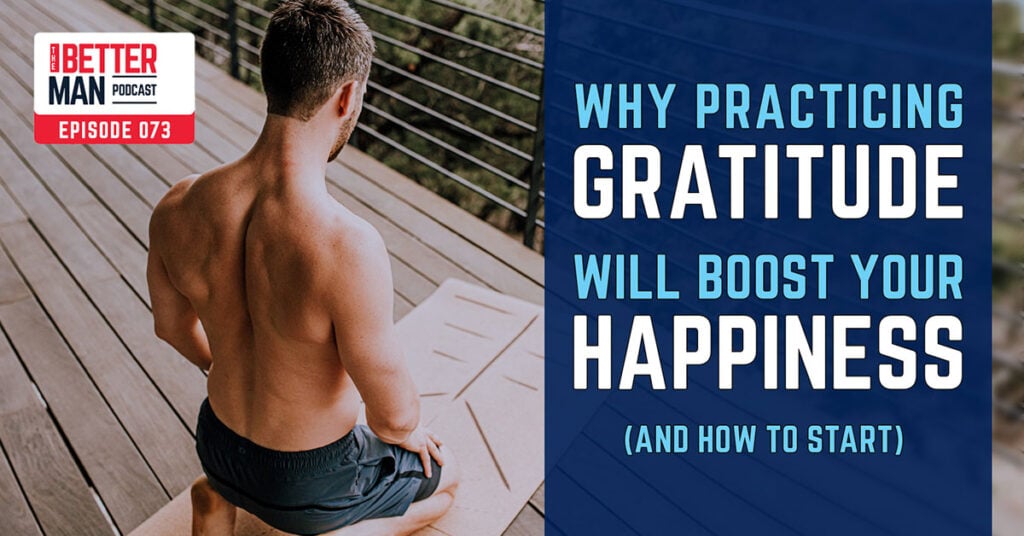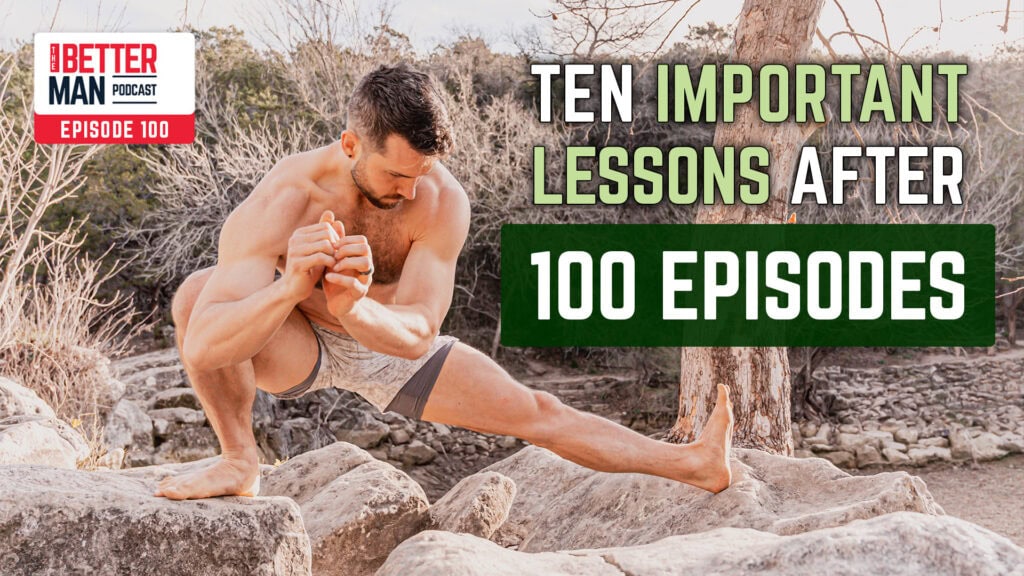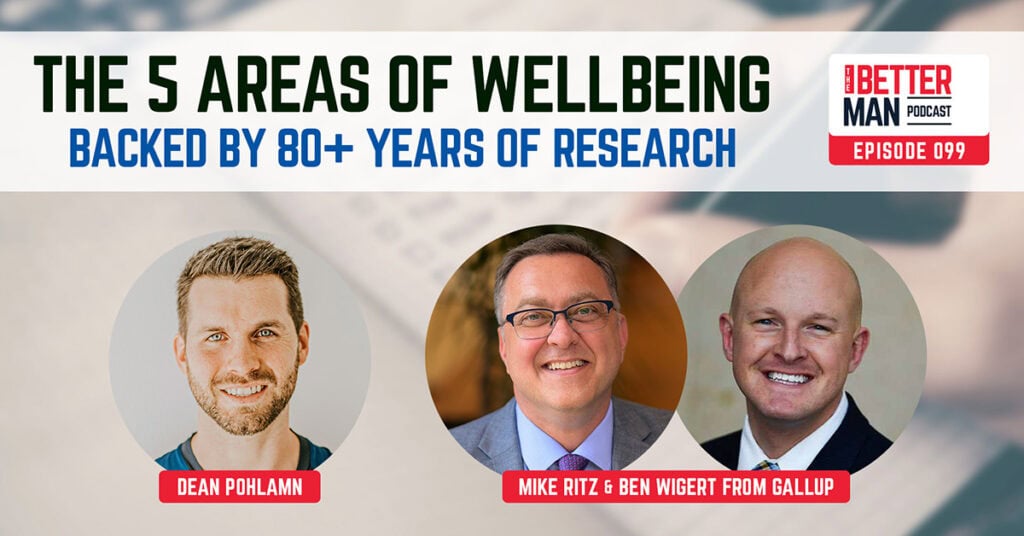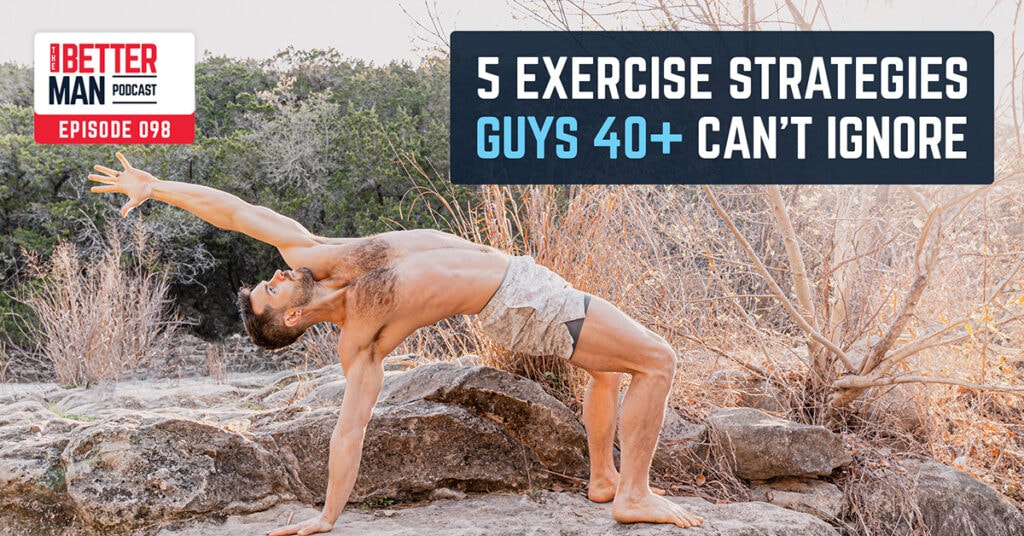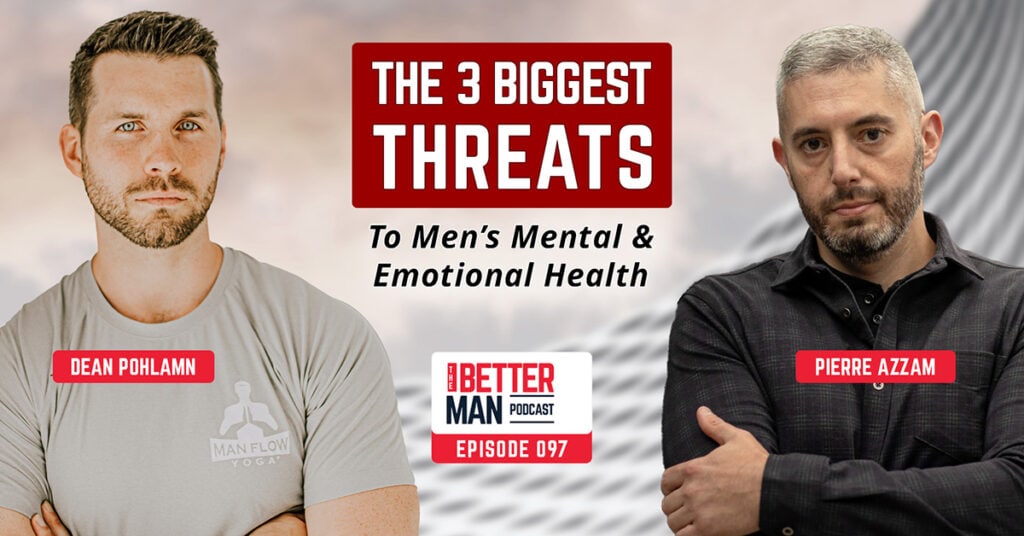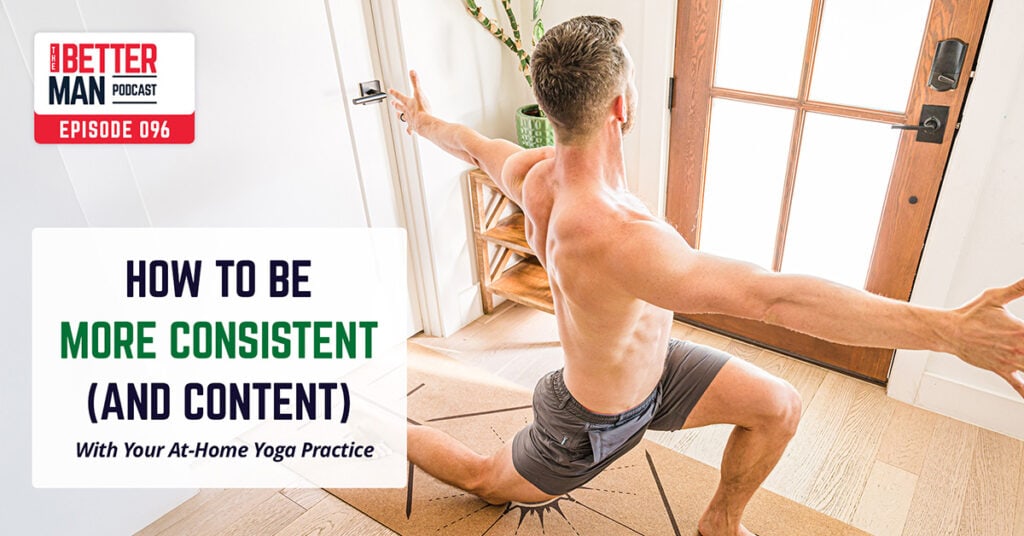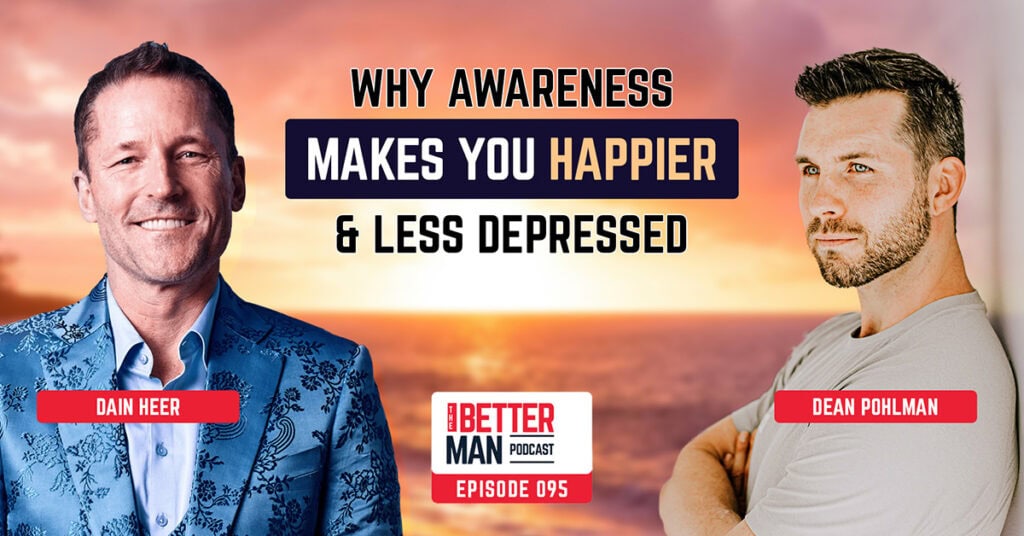Hey, guys, it’s Dean. Welcome to the Better Man podcast. Today, in honor of Thanksgiving week, I’m going to be talking about the power of a gratitude practice and how spending just a few minutes on gratitude every day can lead to dramatically improving your overall quality of life. Just a few facts on gratitude to help get the ball rolling here.
Harvard Health shows that gratitude is strongly and consistently associated with greater happiness. It can improve physical health. People who practice gratitude report fewer aches and pains. Practicing gratitude can also play a major role in overcoming trauma. It helps to reduce social comparisons. It improves your sleep. If you practice gratitude before you go to sleep, you’ll sleep longer and better and you’ll go to sleep with less stress and a greater sense of calm.
It can also improve empathy. It reduces aggression. If you express gratitude in the context of a relationship, it can help you feel more positive to your partner and vice versa, and even makes you both feel more open to discussing concerns in your relationship. So there’s a lot of reasons why we want to practice gratitude, but there may be some roadblocks, mostly mentally, to getting started.
So I want to talk about some strategies that you can use to implementing your own gratitude practice. I’ll tell you exactly what I’ll do. I can also talk about why gratitude is hard. A lot of us might feel kind of silly doing it for the first time. Maybe if we grew up in a success oriented household like me, it feels kind of silly to sit down and talk about things that you’re grateful for when you think that you could be optimizing that time and doing something else and being more efficient with your time.
So I’ll talk about why gratitude can be really helpful, and then I want to make sure that you have some ideas on how to actually do this. Can you do it on your own? Can you do it with a partner or do you have to talk about it? Should you journal it? So I’ll go through some of those as well.
And lastly, I just want to talk about some things that I’ve noticed personally since starting a gratitude practice, and I’ll start off with talking about how this gratitude practice of all for me in the first place. So you may or may not be aware of this, but I lost my dog of over eight years in July, on July 30th of 2023 and this was really painful for me.
I’ve never had any sort of really significant loss before. I’ve never lost anyone really close to me. And it was it was really tough. I cried more than I’ve cried in a very long time. And it was it was all consuming for 2 to 3 days. And as it was happening, I resolved to myself that I would go through the grief process entirely.
I didn’t want to avoid that grief because I didn’t wanted to pop back up in my life later on and potentially damage relationships or other things that were important to me. So I decided to really lean into the entire grieving process. And for part of that I decided that I would go out every night and onto my patio just outside, and I would talk to Tran.
I would just tell him the things that I wanted to tell him. And after a week or so, it kind of evolved into this, this gratitude practice. I started talking about why I was grateful for Tran, all the things that he taught me, all of the positive experiences and the lessons that I took away from our relationship. And then I started talking about things that I was grateful for outside of that, things in my business, things in my personal life, relationships and over time that evolved into my gratitude practice.
So now I have a gratitude practice. Every night before I go to bed, I open the sliding door. I walk outside, usually into my patio. I sit down there and I just kind of list off things that I’m grateful for. And it was kind of hard at first. It just, you know, it felt kind of weird. I don’t know if I had time for it.
I didn’t always feel excited to do it, but I really committed to it for a few weeks. And after I did it for a few weeks, I noticed that I was very it was a lot easier for me to go to bed with this greater sense of peace. So I felt a lot less stressed about things. I also started to look forward to my evening gratitude practice.
I didn’t. It was sometimes hard to get started. Sometimes I felt silly getting started. Or if I was, you know, stressed about work or stressed about relationships, then it was kind of hard to get going. But as soon as I started, all of the things I’m grateful for just kind of started rolling off the tongue. And by the end of it, I was I felt much more at peace than when I started.
And there’s a reason why gratitude is hard. It is because we are focused. We are wired to focus on the negative. So biologically, it’s very easy for us to focus on what is threatening us, what’s wrong, what can potentially derail our sense of peace or our security. So our brains are wired to find those threats. It’s actually very unnatural for us to think about the good things, and that’s why it’s a practice gratitude is a practice to be happier, and the more we practice gratitude, the easier it becomes, the more it carries over into our day to day life.
So if you find that you yourself are and I think I used to associate myself or think of myself as a more negative person a few years ago, but since I’ve embarked on this life changing process that that I’ve really gotten into in the last few years, practicing gratitude has become much easier. And practicing gratitude for me is difficult, or especially difficult when I’m expressing it to another person because there’s vulnerability involved there.
And I have, you know, whatever internal walls that I have built up to to being vulnerable. And that’s a that’s a topic that I’ve explored a lot here on the Betterment podcast. And I can I can do that again later on another time. But so for you, it just might feel weird, it might feel silly, kind of expressing things that you’re grateful for, especially if you’re doing it in a way that doesn’t feel authentic.
So if you’re going out going, I say going out, but I mean, like, I mean going into the you know, some calm place and expressing gratitude. I don’t mean going out to the bar, but if you are practicing gratitude and you’re doing it from this inauthentic place and you’re just saying things that other people are saying, then it might not really feel that great to you.
And also, if you’re if you’re ignoring reality in the context of your gratitude practice, like if you’re only thinking of things that are, if you’re only focusing on things that are really good and not able to view the things that are bad, quote unquote, and think about them from a different perspective, one in which you can be grateful for, then it might not be as helpful as you think.
So here are some strategies that I’ve implemented in my own gratitude practice that I think can be helpful for you. Also, keep in mind that I go out and I, you know, I just look at the sky and I talk to it or I just go outside and I talk to I just kind of look around at whatever sense of whatever is out there that I think and I kind of talk to that.
But you don’t have to do that. There also doesn’t have to be any sort of religion or or or dogma attached to it. Whatever your relationship with the universe or doesn’t look like you are, welcome to practice your gratitude in that way. You can also journal about it. You can talk about it aloud lots of different ways. Whichever way feels more authentic to you and feels like it’s doing something, then you can do that.
And keep in mind, I would do it for at least 2 to 3 weeks before you say, Oh, this isn’t really doing anything for me. All right, so let’s get into those strategies. So first off, I would say you want to start your gratitude practice with things that are easy and authentic. So sometimes it’s hard, just like a workout.
It’s kind of hard to get the ball rolling on the practice, right? You might show up and you just might not be feeling that grateful, or you might show up to your workout and you might just not feel like working out. So you warm up, right? You do some warmup exercises, you go for a walk and then you ease into your workout.
It’s the same thing with the gratitude practice. So if it doesn’t feel authentic to go straight into, you know, a very heartfelt gratitude practice, then you can start with things that are easy. You can start with something like, I’m grateful that I have the chance to do this gratitude practice. That’s something right there, or I’m grateful that I can, you know, that I got to choose my dinner tonight, or I’m grateful that I live in relative security or whatever it is.
But start with something that’s easy and authentic. I would also say that you want to be specific with your with your gratitude practice. So don’t just name the same things over and over. Try to focus on something specific about them. Not to say that it isn’t a bad thing to repeat things, but the more specific you can be, the more you’re going to have to think about it and the more you will genuinely feel that gratitude.
I would also say make sure that it’s in terms of it being authentic. You want to be able to feel that gratitude as isn’t just saying things and you might have to start with just saying things, but eventually you really want to express them in a way where you’re feeling the emotion behind that gratitude. It’s it’s not going to be as helpful if you’re just reciting things and you’re kind of doing it in like a dead voice or you’re not, you know, really feeling it as you do it.
So if you can, maybe you just start with saying it, but if you can do it in a way and ease into actually feeling what you’re grateful for as opposed to just saying it or writing it, that’s going to be helpful. The other tip I have might be a little counterintuitive, but it involves it’ll make total sense once you can understand it, but it involves looking at roadblocks or struggles or difficulties as blessings in disguise.
So you’ve probably heard this phrase it was a blessing in disguise. And I truly believe in this. It’s very easy to look at problems that you have and to be able to think about them in a grateful way because you might just have to think about it in a different way, but it is there. So for example, here’s a good example, but if I’m in an argument with my wife and she’s mad at me that day and she’s not talking to me because we had an argument a few minutes before then or something, then I go out into that gratitude practice and I say, Wow, you know what?
I am so grateful that my wife cares about me that much, that she’s willing to spend this amount of energy on this argument. If someone didn’t love you, they probably wouldn’t be willing to spend that much time and energy on it. So I look at it like that when I look at problems that I have with my business or struggles that I’m going through, I try to look at them in a way that that that that shows me that I have control in this situation.
So, you know, if I’m going through something with my business that makes me, you know, anxious or worried, it’s I it’s easy for me to be able to say, oh, man, I’m just really depressed about this. I don’t feel good about this. But on the other hand, now it’s easy for me to look at that and say, wow, how how lucky am I?
How fortunate of my that I have the opportunity or I have the privilege of being able to be in this situation in which I have control over my own situation. So looking at things that you’re struggling with and trying to find a sense of agency and them are trying to find your sense of control in them can be very helpful when it comes to other problems that I’m experiencing.
I look at them as opportunities because I get to figure out how to fix them. It’s an opportunity for me to grow either as a person, maybe it’s emotionally Mayes, maybe it’s emotionally. When I’m when I’m dealing with something and it’s I’ve uncovered some sort of, you know, trauma or I’ve uncovered some sort of trigger that that makes me upset, that brings up some vulnerability.
And now I’m like, Oh, I get to I get to work on this problem so that I can have a greater sense of peace. I get to know about this this festering wound, so now I can fix it and I’ll be able to feel better moving forward. Or if it’s with my body, then it’s this it’s this sense of, wow.
Well, you know what? I’m glad that this issue presented itself sooner rather than later, because right now I have this minor pain that I’m dealing with. But if it had come out in a more major symptom or more significant symptom, then maybe I’d have a major injury. I was dealing with. And then I also wouldn’t be able to learn about how to fix this injury.
So if you can look at problems as opportunities or look at them as blessings in disguise, then it really helps you with realizing that you have really helps with your outlook on things. It’s going to help you just be happier and it also helps you with dealing with the situation, finding some positives of it. It’s not about denying the negative aspects of things you don’t want to try and trick yourself into a set you sustain.
A situation doesn’t suck if you genuinely feel that it sucks, but for most things there is an opportunity in there that you can find, that you can learn something from. And you know, it might not be popular to say it aloud. It might not be popular to, you know, to do this to someone else. You definitely don’t want to hear somebody else’s problem.
And then tell them, well, you’re looking at this the wrong way. You know, this is this is a this is an exercise that you do for yourself. You do not impose this on other people. You definitely don’t impose it on your partners. You don’t oppose it on imposing on people who are vulnerable, vulnerable enough to share the problem with you.
But if you can do it with yourself, it’s going to help you tremendously. So for me, my gratitude practice could take anywhere from 2 minutes. And sometimes it takes longer. Sometimes it takes me 15 or 20 minutes. Sometimes I turn it into more of this discussion with myself and I can also we then things like, Hey, I’m really struggling with this.
This is what I and I just kind of talk about it aloud until I can frame it in a way where it’s something that I’m grateful for. So if I’m, you know, if I’m stressed about let’s say I’m stressed about money. So if I’m stressed about money, then maybe I, you know, I talk about the struggle. I talk about, well, what have I learned from this?
I’m grateful that I’m able to learn about why this issue occurred, why I’m grateful that I’m able to be in this situation where I’m tested and can come up with a solution in order to overcome whatever it is. So and problems often come about as a result of past behaviors or actions, because the problem is happening now and we’re experiencing it, we actually get to do something about it.
But if the problem didn’t happen at all, we wouldn’t have done anything if the if the result of that problem wouldn’t have created any consequences, then we might not have done anything to fix it. And that would have been a lost area of opportunity. That would have been a lost area of growth. So there’s a lot of ways to do this, but you can be grateful for a lot of different things, even if they appear to be bad at first.
So the ways you can do this, you can do it in a journal. If you haven’t done a gratitude practice before, I would recommend journaling. That’s the easiest way to do it. It is kind of difficult to just start talking aloud and being, you know, talking about what you’re grateful for. It just might feel weird. So journaling is a good way to do it, and I would focus more on consistency rather than depth.
So if for you that just means opening up your journal and scribbling down one thing that you’re grateful for, that’s great because that’s a lot easier to be consistent with and writing an entire page out. So start small and build from there. You can also do it aloud. You can kind of do it in a in a in a sense of a prayer if you want to think about it like that again, doesn’t have to have any sort of religious connotations to it.
But if you if it feels authentic and it feels good to you, you can try just doing it aloud. You can try involving your partner for me, whenever I feel like my wife is down or whenever she notices that I’m being, you know, if I’m just kind of drowning in negativity, we will ask each other like, hey, like name things.
Name three things that you’re grateful for. And sometimes we’ll look at the other person and kind of groan at them or say, Really? But we usually do it. We almost always respond with three things that regret before and we feel a little bit better afterwards. So that’s something else that you can do. And again, if you’re curious, well, how is this going to help me?
Willie Nelson famously said that his life when I started counting my blessings, my whole life turned around. So I like to remember that quote when I’m thinking about, you know, motivation to practice gratitude. And then for me, it took a couple of weeks. I would say that doing this regularly, it took me about 2 to 3 weeks to really start looking forward to my gratitude practice.
And now it’s something that I have. Honestly, I don’t think I’ve skipped a night since since August. So this is, what, a three, four month habit for me that feels effortless. I think it really doesn’t feel like a struggle at all to go outside, sit down and talk about some things that I’m grateful for. So I notice that I have a greater sense of peace.
I notice that I’m able to go to bed really quickly. I have not I’ve had a lot of struggles over the past few months, but when I go to bed, I am out. I am out and it is fantastic. So I would definitely attribute my my gratitude practice to that. Also not watching TV before bed really helps. But yeah, gratitude practice definitely helps with that.
And then I also notice that I’m just thinking more, more, more positively. In general, I’m not as likely to ruminate on negative things, even if I have some struggles that I’m going through or some problems that I’m going through. They just don’t seem as they just don’t seem as significant. They just seem less significant. And if I look on paper and what those problems are, and I would look at them six months ago, I would say that a lot of the problems that I have right now are are more significant than what was going on six months ago.
But they just don’t feel as significant. And I would attribute a gratitude practice for that. So so that’s the that’s the gratitude I hope that you can walk away from this with with a sense of how to start a gratitude practice. And I would also be remiss to not talk about our Black Friday offer. So if you are not already if you’re not already aware, what I do is man for yoga and that is fitness centric on demand yoga workout specific made for men who are interested in getting stronger, getting rid of pain and they want a non religious aspect or a non spiritual approach to yoga.
So that’s all at man flow yoga dot com on the members area and the app. And for the first time ever we are offering a lifetime access deal, a one time price pay once, never pay again and never have to worry about where you’re getting your yoga programs, your workouts, schedules of workouts or tutorials. So why would you sign up for a man for yoga?
Well, here’s why most people sign up there are three reasons. The first one is that it’s yoga specifically made for men, for men’s limited flexibility levels, for men’s fitness interest, for their fitness goals, and for the differing anatomies that we have. So we also focus on a lot of male specific problems. We actually just put out a pelvic floor series this month.
The second big reason is it’s non spiritual, so a lot of other most yoga programs will draw from some elements of Eastern religions. And there is some fear that by doing that that it will compromise your own religions if you’re, you know, Western, European. So we have a non-religious, non spiritual approach to yoga. We don’t talk about chakras, we don’t talk.
There’s no elements of Eastern religion, there is no chanting. This is purely focused on the physical fitness aspects. And that’s not to say that we don’t work on breathing, that we don’t help you achieve a sense of inner peace by focusing on your body awareness, focusing on your breath, and helping with stress relief. But we do it in a way that is non spiritual and non-religious.
And then the third big reason why people sign up is it’s technique focused. So we focus on the proper technique, what you’re supposed to be doing with your body, what you should be feeling, what you shouldn’t be feeling. What are the target muscles? What does this doing for your body? What what does this pose actually doing in terms of your overall fitness?
Is it helping to relieve back pain? Is it targeting your knee pain? Is it going to help with your posture? Those are things that we discuss as we’re going through the workout. So it’s a very educated experience as you’re getting a fantastic workout. Who’s it for? So mental yoga is really made with middle aged guys in mind. It’s men in their late thirties, 40 or 5060s and seventies.
Most guys, our most popular demographic is men in their fifties. I would also say that a couple other uniting factors most guys have some sort of pain they’re dealing with. It could be pain from a previous injury. It could be an accident that they had. It could be lifestyle related. Maybe they sit at a desk a lot and they just have pain from sitting on a desk.
Or it could be from people who work out regularly and they just are experiencing pain that they didn’t used to when they were in their twenties. So if you’re a runner, if you lift weights, if you do whatever you do, bootcamp style workouts or cross training, and you notice that you’re having low back pain when you work out or shoulder pain or knee pain and things just don’t feel as good as they used to, then those are people that can really benefit from mental yoga.
So the one uniting feature of these guys is pain. Most guys have pain in some form or another. They want to get rid of it. And Manville Yoga is awesome for that because of all the things that we do, the isometric strengthening, which helps to build muscle, the increasing and flexibility, which helps to relieve pressure on your joints, things like back pain, knee pain.
And then also the recovery work which helps to alleviate soreness, helps to alleviate pain and can help you get back to your other workouts more quickly with less soreness. So there’s tons of people who can benefit from manual yoga and most of our guys are in their fifties and then forties or sixties on the other end. But these are workouts that I personally do and they help me tremendously.
So even if you’re younger, I think they’ll help you as well. And why do they stay? So the big reasons that people stay with man for yoga, first off, is the noticeable results. People feel less pain when they’re doing these workouts. If you’re doing these workouts at least three times per week, anywhere from three and up to seven or more workouts per week, your pain just starts to go away.
Dramatic reduction in overall pain. And I think what’s significant here is you might not realize how tiring pain is. Pain takes a lot of energy. It just saps energy. And when you’re not in pain, everything is a lot easier. So pain relief is one of the biggest reasons why people stay. They also have noticeable improvements in their physical health.
They feel stronger in their day to day tasks. They feel the benefits of more flexibility. If you’re doing other workouts, you’re going to notice that your performance improves in other areas, but you don’t get as sore as easily, that you don’t get injured as easily. There’s also this greater sense of confidence in long term health. So people really like that.
They’re doing workouts on a consistent basis that they can feel themselves getting stronger, and that helps them be more confident about their future. When one really big uniting factor of people doing mental yoga is an interest in longevity. So people want to live longer, more high quality lives. They don’t want to be older and have to be dependent on somebody else.
So doing these types of workouts, taking care of your body is doing things that can help prevent injury and maintain muscle mass. As you get older can help tremendously with building this greater sense of confidence in your long term health, not to mention your long term health itself. So and then also mentioned are supportive community. We have an incredible Facebook group this is we just actually had 5600 guys in that group, not to mention the many thousands of more customers and members who aren’t in the Facebook group.
But this is an incredibly supportive area where people come with more than just physical fitness problems. People talk about, you know, their cancer struggles in there. People talk about loss, whether that’s that’s from humans or from animals. So there’s a lot of really significant conversations that happen in that community where people feel safe enough to come and get support from other men who are going through a lot of the same struggles.
So it’s a very encouraging community and it’s it’s something that I’m incredibly proud of that we’ve been able to build. And then the last thing that I’ll mention is just the continued access to various levels and programs and workouts and the way that we’ve organized them. So whether you are new to yoga or you’ve been doing yoga for decades, there’s something for you in Mantle Yoga.
We actually send people who are new demand for yoga, even if they have been doing yoga for decades. We send them to our a lot of our beginner programs because it’s going to reteach the way that you do yoga when you start to focus more on the proper muscle engagement, you really focus on proper technique because a lot of yoga studios and a lot of yoga instructors just don’t focus on the technique.
To the extent that I do in the workouts, you’re also able to find the workouts based on skill level, intensity and duration. So you’re able to look for a workout. Our program, depending on what you need that day, some days you’re going to feel more energetic, some days you’ll feel not as energetic, and you need an easier workout.
So it’s great that you’re able to find what you need for that day. And then if you want more of a guided process, we have an entire program progression that starts you at our most basic program and works you up to an intermediate program and beyond. That will take you over two years to complete. So we have over two years not mentioning all the other programs that we have and built into this program.
Progression of workouts to help you progress along your fitness journey. There’s also a Getting Started guide to help you get started and be consistent. That’s the biggest thing that we focus on because without the consistency of the workouts, none of this matters. And so we focus on things like motivation, discipline, how to structure your environment to to be more consistent with your workouts and those kinds of things.
No strategies, and that’s a huge help. We have this 90 day onboarding process to help you get started and help you be successful. You don’t want to just have you come in and then say, here’s the workouts, do them. We really guide you through how to be successful at them, how to be consistent and using strategies that are actually used by our customers.
We don’t just make these up. These aren’t theoretical. These are things that our customers have been using for years to be successful. So if you are looking for a yoga resource, that’s going to help you be more consistent with your workouts so that you can get results, so you can build strengths, you can increase flexibility, so you can get rid of pain and work on your fitness in a way that’s going to help your long term health.
No matter what your age is, then there’s no better solution than man for yoga. If you’re looking for that fitness centric approach to yoga, specifically made for men and their fitness goals, their bodies, their challenges, this is it. This is the way to go. And so what we have for Black Friday is a lifetime access offer where you pay one price and then you have access to the member’s area and the app for ever.
And I won’t tell you the price here. You’re going have to go to the website to find out go to man for yoga dot com. There’s actually a link in the shownotes click that but I will tell you that it is actually less than the cost of a one year subscription on a monthly access basis. So the lifetime offer costs less than one year of membership at a monthly price.
It’s a ridiculous deal. It’s amazing. So so if you are clarifying this, so if you signed up for mental yoga at a monthly subscription and you multiply that by 12, it would still be more than what this one time price is to get lifetime access to the member’s area, an app for man for yoga. So it’s an incredible deal.
I invite you to go take advantage of that. This is for both members and nonmembers. We haven’t done this before. We don’t know if we’ll ever do it again. So this is your opportunity to take it. It’s only going to be live through Cyber Monday so manual yoga dot com to sign up. And that’s what I have for you today.
Guys, I hope you got something out of this podcast. I hope you are motivated to do a gratitude practice. I hope this wasn’t a waste of your time with me talking about the mental yoga app and member’s area. This is the reason why I do all of this. This is the primary way that I help people is by helping them with their physical wellness.
And then hopefully from there you can tap into all these other aspects of health that we talk about in the Better Man podcast. But without your physical wellness, all of these other things are going to be difficult. If you have pain on a regular basis, your life is going to be more difficult if you’re not exercising regularly, you’re going to have less energy and your life is going to be more difficult.
So exercise for me is something that has always been something that I’m passionate about and what I would say is unique about Man for Yoga is that it is exercise that produces results with minimal strain on your body, so you can build muscle, you can get rid of pain, you can feel great, and you won’t be beating up your body in the process like a lot of other workouts do.
So I think that’s what really makes Man for Yoga unique, and that’s why I would encourage people to to give it a shot. So there. All right, guys, thanks for listening. I hope you enjoyed this episode of The Better Man podcast. I’ll see you on the next one. Please don’t forget if you haven’t already subscribe to the podcast, follow it however you do that on whatever major podcast platform you do, you can also do this and you can also follow along in the Mansfield Yoga app and members area.
We have all the podcast there as well, and if you haven’t already, please consider leaving a review for us at whatever podcast platform you listen to. I think we’re about 108 reviews now on Apple Podcasts, so I’d love to see that number go up. If you could help out, I’d really appreciate it. All right, guys, that’s all I’ve got.
[END]
